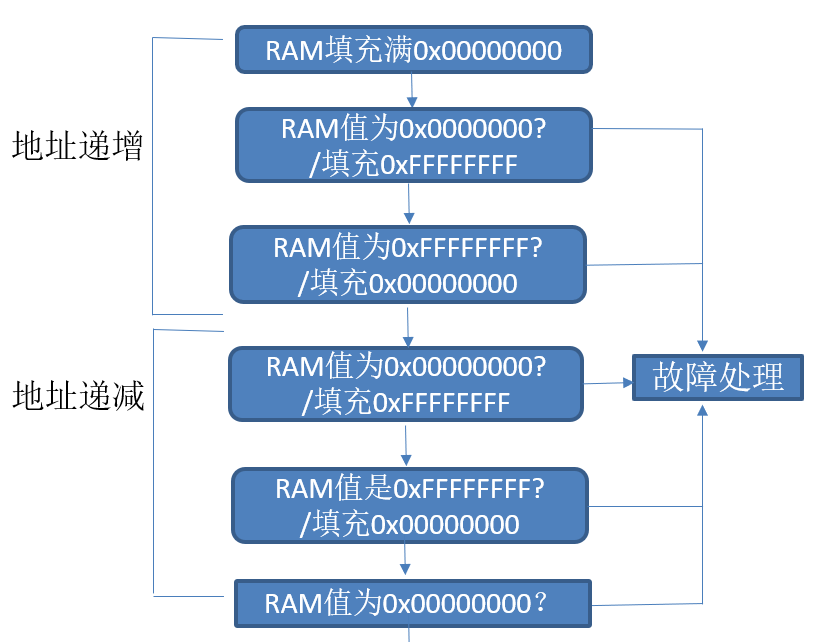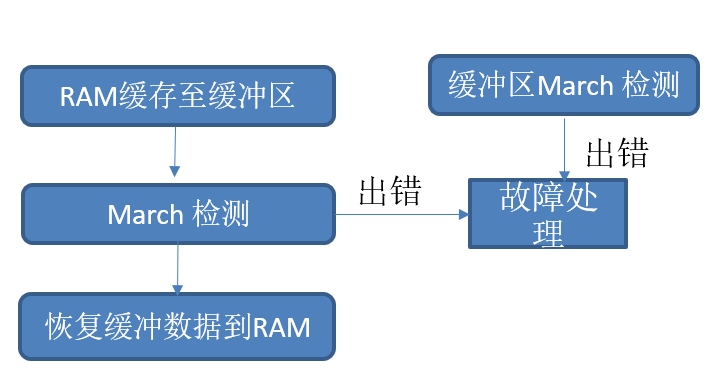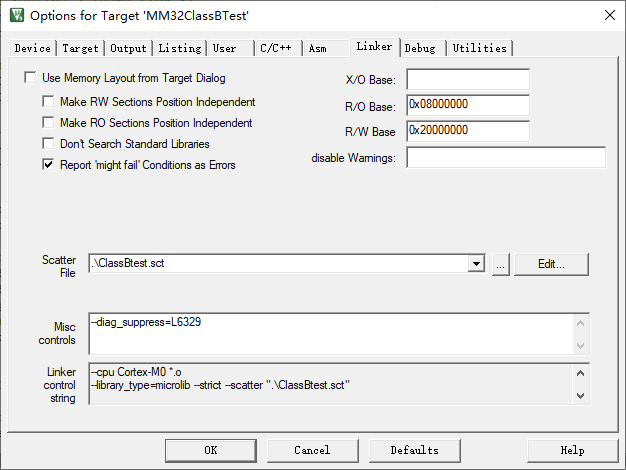在上一章节中我们介绍了CPU寄存器检测的实现方法,本章节我们将给大家介绍RAM检测的实现方法。
SRAM检测不仅检测数据区域的错误,还检测其内部地址和数据路径的错误。
检测时由于需要执行软件算法(March-C),会影响CPU的利用率,所以SRAM测试采用拓扑模式,按位阵列推进测试,阵列中的逻辑邻位(属于单字)物理上彼此分离,而带后续逻辑地址的字对在物理上却共享邻位,此时可采用按字测试的方法。
SRAM自检采用March-C算法,March-C是一种用于嵌入式芯片RAM测试的算法,是安全认证的一部分,可用于测试那些未被硬件奇偶校验覆盖的部分RAM。为了不影响MCU的运行,将RAM分成很多小块,每次测试其中一块, 先将要测试的块清零,然后按位逐位置1,每置一位,测试该位是不是1,是就继续,不是就报错;全部置完后,再逐位清0,每清一个位,测试该位清0是不是0,如果是就正确,不是就报错。如果是对工作区的RAM,数据需要保留,在RAM中开一个安全保留区,先对安全保留区March-C,然后把要测试的区的数据copy进安全区,再对要测试的工作区进行March-C,测试-- copy进安全区-- 测试-- copy进安全区...... 完成整个空间的测试。
在ClassB检测中,RAM自检也分为启动自检与运行自检两部分。
01、ClassB RAM启动自检
RAM在启动自检过程中会检测全部的RAM。算法中会用值(0x00000000)和值(0xFFFFFFFF)逐字填充,填充后读取出来比较看值是否相等。
具体的运行流程图如下:

主要有6步:
-
对所有测试单元写0 (按地址增加的顺序)
-
逐个检测每个单元是否为0,如果全为0,然后写为0xFF* (按地址增加的顺序)
-
逐个检测每个单元是否为0xFF*,如果全为F,然后写为0 (按地址增加的顺序)
-
逐个检测每个单元是否为0,如果全为0,然后写为0xFF* (按地址递减的顺序)
-
逐个检测每个单元是否为0xFF*,如果全为F,然后写为0 (按地址递减的顺序)
-
逐个检测每个单元是否为0(按地址递减的顺序)
Class_FullRamMarchC
PUSH {R4-R7}
MOVS R4, #0x1 ; Test success status by default
MOVS R3,R2 ; setup inverted background pattern
RSBS R3, R3, #0
SUBS R3,R3, #1
; *** Step 1 ***
; Write background pattern with addresses increasing
MOVS R5,R0
__FULL1_LOOP
CMP R5,R1
BHI __FULL_RET
LDR R7,[R5, #+0]
STR R2,[R5, #+0]
LDR R6,[R5, #+0]
CMP R2,R6
BNE __FULL_ERR
STR R3,[R5, #+0]
LDR R6,[R5, #+0]
CMP R3,R6
BNE __FULL_ERR
STR R7,[R5, #+0]
ADDS R5,R5,#+4
B __FULL1_LOOP
; *** Step 2 ***
; Write background pattern with addresses decreasing
MOVS R5,R1
SUBS R5,R5,#+4
__FULL2_LOOP
CMP R5,R0
BLO __FULL_RET
LDR R7,[R5, #+0]
STR R2,[R5, #+0]
LDR R6,[R5, #+0]
CMP R2,R6
BNE __FULL_ERR
STR R3,[R5, #+0]
LDR R6,[R5, #+0]
CMP R3,R6
BNE __FULL_ERR
STR R7,[R5, #+0]
SUBS R5,R5,#+4
B __FULL2_LOOP
__FULL_ERR
MOVS R4,#0 ; error result
__FULL_RET
MOVS R0,R4
POP {R4-R7}
BX LR ; return to the caller02、ClassB RAM运行自检程序
RAM在运行自检的过程中只检测部分RAM,不会检测全部的RAM。目前主要自检0x20000030-0x2000007B范围内的RAM以及0x20000000-0x2000001F缓冲区范围的RAM,具体的操作流程如下:

在mm32_RamMcMxKeil.c进行如下操作:
; ***************** test of the RAM slice ********************* MOVS R5, #0 ; NO - save content of the RAM slice into the backup buffer __SAVE_LOOP LDR R6,[R4, R5] ; load data offset LDR R7,[R0, R6] ; load data from RAM ADDS R5,R5,#4 ; original data are stored starting from second item of the buffer STR R7,[R1, R5] ; (first and last items are used for testing purpose exclusively) CMP R5, #20 BLE __SAVE_LOOP ; *** Step 1 *** ; Write background pattern with addresses increasing MOVS R5, #0 __STEP1_LOOP LDR R6,[R4, R5] ; load data offset STR R2,[R0, R6] ; store background pattern ADDS R5,R5,#4 CMP R5, #20 BLE __STEP1_LOOP ; *** Step 2 *** ; Verify background and write inverted background with addresses increasing MOVS R5, #0 __STEP2_LOOP LDR R6,[R4, R5] ; load data offset LDR R7,[R0, R6] ; verify background pattern CMP R7, R2 BNE __STEP_ERR STR R3,[R0, R6] ; store inverted background pattern ADDS R5,R5,#4 CMP R5, #20 BLE __STEP2_LOOP
在MDK工程的mm32_STLClassBvar.h文件中设置一些变量进行定址,并在工程配置中设定区域。
/* RAM location for temporary storage of original values at run time RAM transparent test */
EXTERN uint32_t aRunTimeRamBuf[RT_RAM_BLOCKSIZE + 2] __attribute__((section("RUN_TIME_RAM_BUF")));
/* RAM pointer for run-time tests */
EXTERN uint32_t *pRunTimeRamChk __attribute__((section("RUN_TIME_RAM_PNT")));
EXTERN uint32_t *pRunTimeRamChkInv __attribute__((section("RUN_TIME_RAM_PNT")));
EXTERN uint32_t aGAP_FOR_RAM_TEST_OVERLAY[2] __attribute__((section("RUN_TIME_RAM_PNT")));
/*Note:the zero_init forces the linker to place variables in the bsssection */
/*This allows the UNINIT directive(in scatter file)to work. On the contrary */
/* all Class B variables pairs should be initialized properly by user before using them */
/* Counter for verifying correct program execution at start */
EXTERN uint32_t CtrlFlowCnt __attribute__((section("CLASS_B_RAM"), zero_init));
EXTERN uint32_t CtrlFlowCntInv __attribute__((section("CLASS_B_RAM_REV"), zero_init));
/* Counter for verifying correct program execution in interrupt */
EXTERN uint32_t ISRCtrlFlowCnt __attribute__((section("CLASS_B_RAM"), zero_init));
EXTERN uint32_t ISRCtrlFlowCntInv __attribute__((section("CLASS_B_RAM_REV"), zero_init));
/* LSI period measurement at TIM5 IRQHandler */
EXTERN uint32_t PeriodValue __attribute__((section("CLASS_B_RAM"), zero_init));
EXTERN uint32_t PeriodValueInv __attribute__((section("CLASS_B_RAM_REV"), zero_init));
/* Sofware time base used in main program (incremented in SysTick timer ISR */
EXTERN uint32_t TickCounter __attribute__((section("CLASS_B_RAM"), zero_init));
EXTERN uint32_t TickCounterInv __attribute__((section("CLASS_B_RAM_REV"), zero_init));
/* Indicates to the main routine a 100ms tick */
EXTERN __IO uint32_t TimeBaseFlag __attribute__((section("CLASS_B_RAM"), zero_init));
EXTERN __IO uint32_t TimeBaseFlagInv __attribute__((section("CLASS_B_RAM_REV"), zero_init));
/* Indicates to the main routine a 100ms tick */
EXTERN __IO uint32_t LSIPeriodFlag __attribute__((section("CLASS_B_RAM"), zero_init));
EXTERN __IO uint32_t LSIPeriodFlagInv __attribute__((section("CLASS_B_RAM_REV"), zero_init));
/* Stores the Control flow counter from one main loop to the other */
EXTERN uint32_t LastCtrlFlowCnt __attribute__((section("CLASS_B_RAM"), zero_init));
EXTERN uint32_t LastCtrlFlowCntInv __attribute__((section("CLASS_B_RAM_REV"), zero_init));
/* Pointer to FLASH for crc32 run-time tests */
EXTERN uint32_t *pRunCrc32Chk __attribute__((section("CLASS_B_RAM"), zero_init));
EXTERN uint32_t *pRunCrc32ChkInv __attribute__((section("CLASS_B_RAM_REV"), zero_init));
/* Reference 32-bit CRC for run-time tests */
EXTERN uint32_t RefCrc32 __attribute__((section("CLASS_B_RAM"), zero_init));
EXTERN uint32_t RefCrc32Inv __attribute__((section("CLASS_B_RAM_REV"), zero_init));
EXTERN uint32_t LSI_Freq __attribute__((section("CLASS_B_RAM"), zero_init));
/* Magic pattern for Stack overflow in this array */
EXTERN __IO uint32_t aStackOverFlowPtrn[4] __attribute__((section("STACK_BOTTOM"), zero_init));在MDK的Options for Target 选项卡中进行如下配置:

在ClassBtest.sct文件中可以看到如下结果:

栈检查的操作原理:设定特定的值在栈底,当检测到栈底的数值发生变化了,就认为栈溢出了。
control_flow_call(STACK_OVERFLOW_TEST);
aStackOverFlowPtrn[0] = 0xEEEEEEEEuL;
aStackOverFlowPtrn[1] = 0xCCCCCCCCuL;
aStackOverFlowPtrn[2] = 0xBBBBBBBBuL;
aStackOverFlowPtrn[3] = 0xDDDDDDDDuL;
control_flow_resume(STACK_OVERFLOW_TEST);
/**
* @brief This function verifies that Stack didn't overflow
* @param : None
* @retval : ErrorStatus = (ERROR, SUCCESS)
*/
ErrorStatus STL_CheckStack(void)
{
ErrorStatus result = SUCCESS;
CtrlFlowCnt += STACK_OVERFLOW_CALLEE;
if ( aStackOverFlowPtrn[0] != 0xEEEEEEEEuL )
{
result = ERROR;
}
if ( aStackOverFlowPtrn[1] != 0xCCCCCCCCuL )
{
result = ERROR;
}
if ( aStackOverFlowPtrn[2] != 0xBBBBBBBBuL )
{
result = ERROR;
}
if ( aStackOverFlowPtrn[3] != 0xDDDDDDDDuL )
{
result = ERROR;
}
CtrlFlowCntInv -= STACK_OVERFLOW_CALLEE;
return (result);
}以上代码是RAM自检的汇编代码,整个算法执行会花费一定时间,如果整个内存范围的测试时间太长,就会对用户应用程序造成较大的局限性,所以将其分成若干片段,这些片段与执行程序的本地区域相一致。对被测试区域进行动态修改,然后进行单独执行测试。检测出问题则会跳转后面的故障函数,可以添加对应的操作进行故障处理。
来源:灵动微电子
免责声明:本文为转载文章,转载此文目的在于传递更多信息,版权归原作者所有。本文所用视频、图片、文字如涉及作品版权问题,请联系小编进行处理(联系邮箱:cathy@eetrend.com)。


